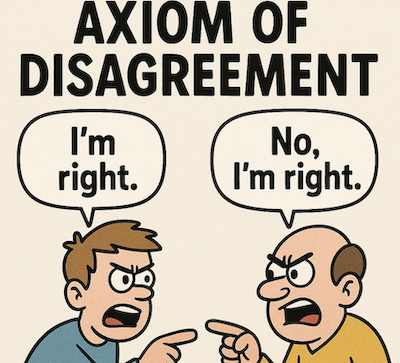My wife and I go out for dinner to our local restaurant. It gets us both away from distractions so that we can have some personal time together. I am very lucky to have a wife that discusses abstract thoughts, particularly when it comes to the relation in the restaurant.
As I am draughting the pages in this site on Set Theory I realise that we can form a set of all the people in the restaurant. To play a game, we can put structure on the set. Let’s put a relation on the set that describes who is dining with who. If we call the set of people in the restaurant ![]() and the relation who is dining with who
and the relation who is dining with who ![]() then we can pair off each diner
then we can pair off each diner ![]() with
with ![]() both of whom are in the set
both of whom are in the set ![]() . The set of all possible permutations of each couple in the restaurant is, in set theory, the cartesian product
. The set of all possible permutations of each couple in the restaurant is, in set theory, the cartesian product ![]() .
.
Of course, not all the people are having dinner with each other. Only the the people for which the dinner relationship is true are having dinner together. I call this ![]() . It is clear, that
. It is clear, that ![]() are a series of pairs of people from the set of all people in the restaurant and so the dinner relation forms a subset of the cartesian product of the set of all people in the restaurant with itself. This sounds complicated. All we are saying is, of all the permutations of two people in the restaurant, there are pairs of two people having dinner together.
are a series of pairs of people from the set of all people in the restaurant and so the dinner relation forms a subset of the cartesian product of the set of all people in the restaurant with itself. This sounds complicated. All we are saying is, of all the permutations of two people in the restaurant, there are pairs of two people having dinner together.
But what about when there are more than two people having dinner together? You can have ![]() for example, but I am getting crafty with the use of a relation. Firstly, unlike the real restaurant, the elements of a set have no concept of being close. We are tempted to have
for example, but I am getting crafty with the use of a relation. Firstly, unlike the real restaurant, the elements of a set have no concept of being close. We are tempted to have ![]() because these three people
because these three people ![]() , who are having dinner together,
, who are having dinner together, ![]() , are sat around a table and close. But this is not what we are modelling. What I am claiming, is that if we have three people
, are sat around a table and close. But this is not what we are modelling. What I am claiming, is that if we have three people ![]() who are having dinner together then I can say
who are having dinner together then I can say ![]() for
for ![]() is having dinner with
is having dinner with ![]() and
and ![]() for
for ![]() is having dinner with
is having dinner with ![]() . I can therefore, in this game, imply that if
. I can therefore, in this game, imply that if ![]() and
and ![]() then
then ![]() . That is, if
. That is, if ![]() is having dinner with
is having dinner with ![]() then since
then since ![]() is having dinner with
is having dinner with ![]() , it follows that
, it follows that ![]() is having dinner with
is having dinner with ![]() . This property, in mathematics, is called transitive.
. This property, in mathematics, is called transitive.
Whilst it sounds semantic, I need to point out that ![]() is also true. That is each person is having dinner with themselves. This, in mathematics is call a reflexive property. We can also say that
is also true. That is each person is having dinner with themselves. This, in mathematics is call a reflexive property. We can also say that ![]() . That is, if
. That is, if ![]() is having dinner with
is having dinner with ![]() then
then ![]() is having dinner with
is having dinner with ![]() . This property of a relation is called symmetric.
. This property of a relation is called symmetric.
Paul Halmos : “To understand mathematics means to forget the differences that don’t matter.”
(A Hungarian-American mathematician)
If a relation is reflexive, symmetric and transitive then it is called an equivalence relation.
It does not need to be this way. I play another game. A more dangerous game. Let’s place a relation on the Cartesian product of the set of people in the restaurant that are having relationships with each other. Let’s call this relation ![]() . I will admit
. I will admit ![]() into the game and say no more. It is clear, hopefully, that
into the game and say no more. It is clear, hopefully, that ![]() . However, it is less clear if
. However, it is less clear if ![]() and
and ![]() then
then ![]() . I think you know what I am saying. It’s likely that this is a non-transitive relation.
. I think you know what I am saying. It’s likely that this is a non-transitive relation.
As the conversation turns to different matters I am reminded that there would be no second date if it were not for the marriage!
Mathematics can describe aspects of many situations around us. All we need do is look to seek out these structures. If you would like to see more of the mathematics behind set theory then start here.



